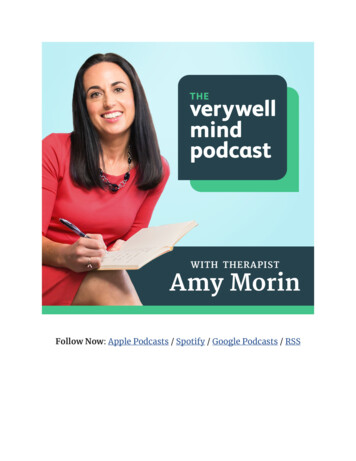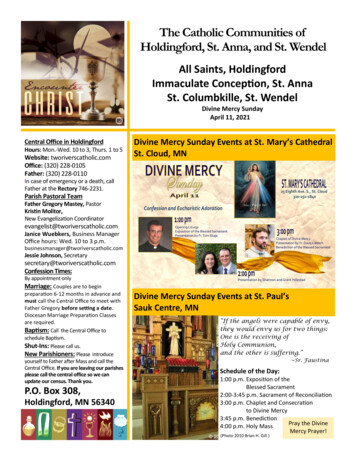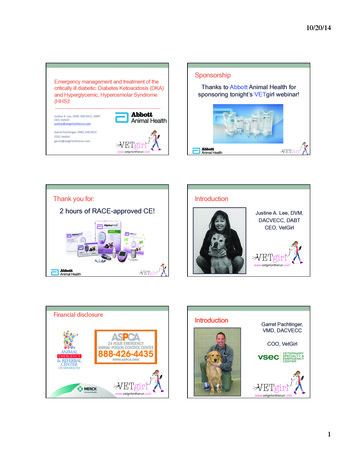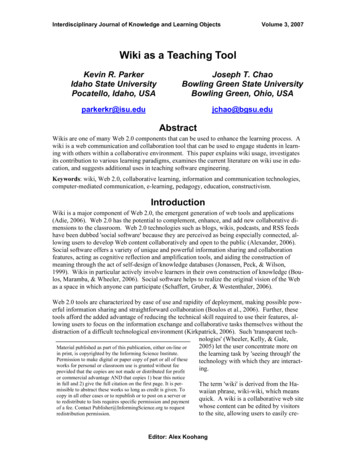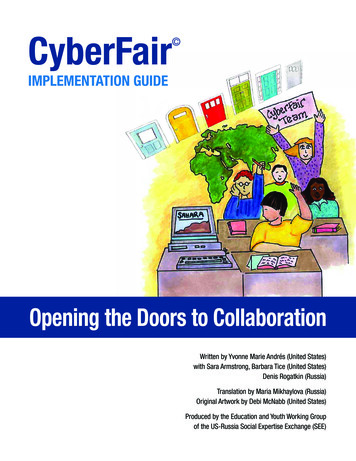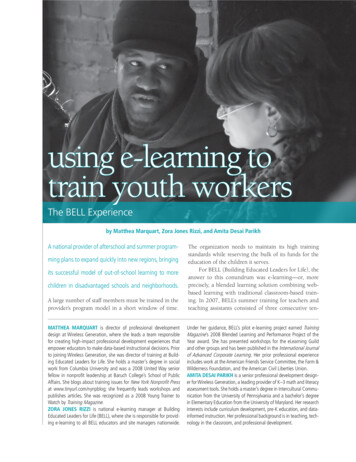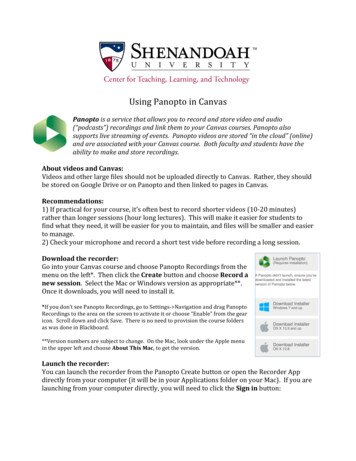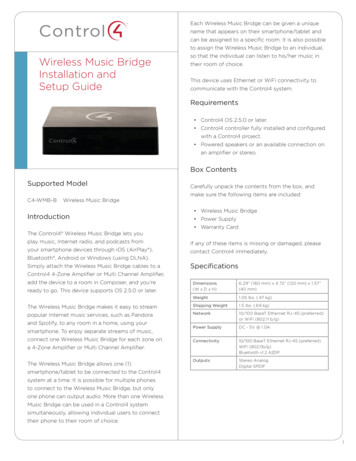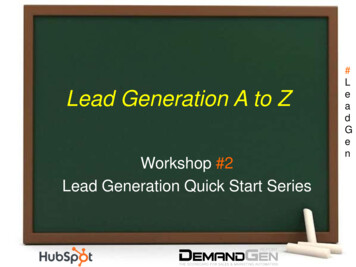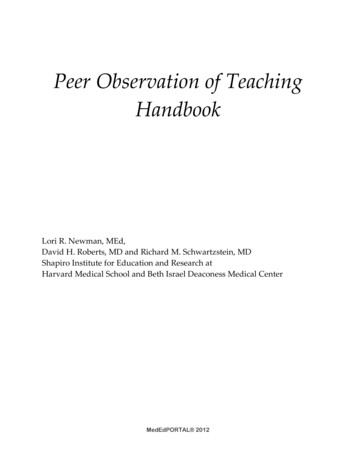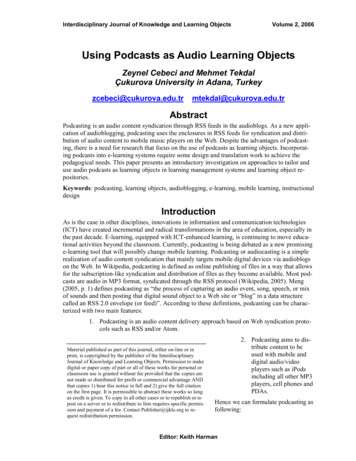
Transcription
Interdisciplinary Journal of Knowledge and Learning ObjectsVolume 2, 2006Using Podcasts as Audio Learning ObjectsZeynel Cebeci and Mehmet TekdalÇukurova University in Adana, trAbstractPodcasting is an audio content syndication through RSS feeds in the audioblogs. As a new application of audioblogging, podcasting uses the enclosures in RSS feeds for syndication and distribution of audio content to mobile music players on the Web. Despite the advantages of podcasting, there is a need for research that focus on the use of podcasts as learning objects. Incorporating podcasts into e-learning systems require some design and translation work to achieve thepedagogical needs. This paper presents an introductory investigation on approaches to tailor anduse audio podcasts as learning objects in learning management systems and learning object repositories.Keywords: podcasting, learning objects, audioblogging, e-learning, mobile learning, instructionaldesignIntroductionAs is the case in other disciplines, innovations in information and communication technologies(ICT) have created incremental and radical transformations in the area of education, especially inthe past decade. E-learning, equipped with ICT-enhanced learning, is continuing to move educational activities beyond the classroom. Currently, podcasting is being debated as a new promisinge-learning tool that will possibly change mobile learning. Podcasting or audiocasting is a simplerealization of audio content syndication that mainly targets mobile digital devices via audioblogson the Web. In Wikipedia, podcasting is defined as online publishing of files in a way that allowsfor the subscription-like syndication and distribution of files as they become available. Most podcasts are audio in MP3 format, syndicated through the RSS protocol (Wikipedia, 2005). Meng(2005, p. 1) defines podcasting as “the process of capturing an audio event, song, speech, or mixof sounds and then posting that digital sound object to a Web site or “blog” in a data structurecalled an RSS 2.0 envelope (or feed)”. According to these definitions, podcasting can be characterized with two main features:1. Podcasting is an audio content delivery approach based on Web syndication protocols such as RSS and/or Atom.Material published as part of this journal, either on-line or inprint, is copyrighted by the publisher of the InterdisciplinaryJournal of Knowledge and Learning Objects. Permission to makedigital or paper copy of part or all of these works for personal orclassroom use is granted without fee provided that the copies arenot made or distributed for profit or commercial advantage ANDthat copies 1) bear this notice in full and 2) give the full citationon the first page. It is permissible to abstract these works so longas credit is given. To copy in all other cases or to republish or topost on a server or to redistribute to lists requires specific permission and payment of a fee. Contact Publisher@ijklo.org to request redistribution permission.2. Podcasting aims to distribute content to beused with mobile anddigital audio/videoplayers such as iPodsincluding all other MP3players, cell phones andPDAs.Hence we can formulate podcasting asfollowing:Editor: Keith Harman
Using Podcasts as Audio Learning ObjectsPodcasting Web syndication (RSS, Atom) Audio content (talk shows, music, news, and certainly learning resources ) Mobile devices (mp3 players, PDAs, cell phones )Here, Web syndication is a way of publishing informational feeds about the new and updatedcontent of a Web site to other Web sites or people who subscribed to these feeds. A feed or achannel is a type of XML file that contains information about new or updated content of a Website or a blog. Although Atom is an emerging protocol, various versions of RSS are primarily being used in building syndications of feeds. RSS feeds (XML files written according to RSS specifications) are created by content publishers/developers and then delivered to their subscribersthrough reading by a feed reader or feed aggregator. Feed readers are the programs that regularlyor periodically check the new information on subscribed feeds and then automatically downloadthe referenced content files to a user’s local device. Long (2003, p. 2) explained that “RSS is primarily used to distribute news and other Web content, and it was originally developed at Netscape to feed news headlines and related information to their portal pages. These so-called channels have become the primary mechanism by which automatic distribution of news and otherevent-oriented information bits are enabled, a process known as providing syndication services".Currently, the distributed content through the RSS feeds is primarily composed of text-basednews headlines, however; the content can also be published in any electronic file formats, such asplain texts, formatted documents, presentations, audios, videos, and animations. Adam Curry’sidea about distribution of audio with RSS syndication came into existence with RSS 2.0 specification. He proposed that any kind of media could be referenced with an “enclosure” tag of RSS.Applying this idea, his audioblogging was published by Radio Userland. In this kind of syndication large objects wrapped up in RSS enclosures can be set to download at night, when traffic islighter. In the morning, the user can have access to large media on their own computer (c.f. Lomas, 2003).RSS 2.0, published in July 2003, is the successor of RSS 0.92. It is the latest version of RSSspecifications. Its “enclosure” element, indicating an audio file in a feed, has been widely used todownload MP3 files to digital audio players automatically. Dave Winer, one of the co-authors ofRSS 2.0, has experimented on audio enclosures of RSS 2.0 with a reader called iPodder on iPods.This kind of syndication is called (mistakenly) “podcasting” because it is related to Apple’siPods. Additionally, during 2004 Apple’s iPod was the most popular DAP because of its highcapacity hard disk compared to other devices with flash disks. The technological superiority ofiPods is further reinforced with the usage of the term “podcasting” for defining audio syndication.A more suitable term, however; could be audiocasting because audio syndication and distributionvia RSS can be applied to all kind of mobile audio players today. It is likely that in the future theterm “podcasting” may be replaced with “audiocasting” as a more descriptive term of audio syndication and distribution.Podcasting is not a new technology but rather a new innovative method of Web-based broadcasting that may be used for automatically transferring digital audio content to mobile devices. It isan XML-based syndication meant to disseminate audio content in the Web that has become wellknown in the last two years. The popularity of audio content syndication makes mobile learningapplicable for a large number of students. Similarly, Downes (2004, par. 15) points that “anemerging trend, called 'mobile learning', foresees the delivery of learning content through mobiledevices such as personal telephones, PDAs and similar tools”. He also emphasizes that “the impact of wireless learning is that, because content is available anywhere, learning is no longer tiedto a particular location. As XML encoded content and syndicated content delivery become entrenched, there will be little, if any, limitation on the place or manner in which learning may beavailable.”48
Cebeci & TekdalThe basic advantage of podcasting in education is the portability and convenience of listening tolearning resources anytime and anywhere without requiring extensive technical knowledge. Podcasts can be automatically downloaded to almost all kinds of mobile devices, such as MP3 players, cellular phones, PDAs, and mobile computers. Learning materials downloaded into mobiledevices can be listened to by learners in their own time and place. But in spite of this technological advantage of podcasting, there are some issues to consider before using podcasts in learningobject based instruction.First of all, if podcasts are described with learning object metadata they should be reusable, accessible, and searchable audio learning objects via learning object repositories (LOR). In additionto reusability, podcasts should also be designed to match pedagogic needs to support learning.Therefore, podcasts should have learning objectives associated with them. Secondly, design ofpodcasts as learning objects should enable its effective inclusion in learning content managementsystem (LCMS) in order to assemble the lessons or courses for various purposes. This will alsoprovide personalization to meet the individual learning style of each learner.This paper primarily aims to introduce the potential advantages of podcasting for education. Additionally, some principles on transformation of podcasts to learning objects and producing audiolearning objects for e-learning through podcasting are examined. Finally interactions between thesystems such as LOR, LMS/LCMS and audioblogs are evaluated.Podcasting and EducationPodcasting or audio content syndication can be considered as a complimentary tool to e-learningdue to some of its inherited pedagogic advantages. Therefore, podcasting should be taken intoaccount as a means to utilize and evaluate the growing prevalence of mobile players in e-learning.Firstly, podcasting serves anytime and anywhere mobile learning. After podcasts are downloadedinto any mobile player, they can be listened to at one’s convenience. The flexibility of merelylistening is a technological advantage of podcasting that may make mobile learning applicable,cheaper, and popular when it is compared to its counterparts such as WAP-based or Web-basedmobile learning.Podcasting has an instant-application potential for education since millions of young people havealready bought mobile music players (mostly MP3 players). In the near future, it is highly probable that the availability of cheaper but advanced technology player devices and applications inmobile market might lead to an increased use of mobile players.Perhaps, one of the most important pedagogic characteristics offered by podcasting is learningthrough listening. For many people, listening may be more attractive and less tedious than reading. It is well known that human beings have used listening as a primary method for thousand ofyears in learning process. Listening may motivate students who do not like reading.Podcasting makes possible content that is attractive to students. In order to attract students, coursecontent could be mixed with short length fragments of popular songs as insertions or speechbackgrounds.Podcasting may also be a useful tool in e-learning environments for the visually challenged. Beyond being an independent way of delivering course content in any audio format, podcasting mayalso be integrated with Web-based e-learning models. Audio recording and podcasting of livelectures given in the classes of arts and humanities may be quickly and practically used by educational institutions. Recording live conversations in lectures is not an expensive and difficult tasksince it may simply be done with the use of devices such as portable speech recorders or evenMP3 players equipped with recording functionality. Podcasts can also be recorded with analog49
Using Podcasts as Audio Learning Objectsdevices, but in this case a conversion process is required to convert analog records to digital audioformats before publishing.Podcasting can also be treated as complementary tool of music, language and theatre education.Universities and other educational institutions can organize the collecting and publishing of audioin a central learning system and/or a podcasting repository. The audio may be published in teachers’ personal Weblogs on the Internet (Norman, 2004). When RSS feeds are published in personalWeblogs or institutional podcasting repositories, they can be easily retrieved by students who aresubscribed to these feeds. Educational institutions may achieve that objective by installing RSSserver software as a part of their existing Web sites or learning management systems to edit andpublish podcasts to students.Podcasting eases accession and selection to a wide range of audio resources in the Web. Thisprovides better cognitive-based personalization in learning. Martinez (2002, par. 12) explainedthat “cognitive-based personalization uses information about learning preferences or styles from aprimarily cognitive perspective to deliver content specifically targeted to differing learner attributes. As an example, learners may choose to use an audio option because they prefer hearing textrather than reading it. Or, a learner may prefer the presentation of content in a linear fashion,rather than a random presentation.”Converting Podcasts to Learning Objects:“Wafers-Like Audio Learning Objects”Currently most podcasts are just audio files recorded and distributed as MP3 files for noneducational purposes. Although many audio objects have been created and used for educationover the years, they are often ordinary speech files that are recorded linearly in one of audio fileformats such as MP3, WAV, RAM, etc. Perhaps these speech-only audios and podcasts are notconsidered as valuable learning objects because they do not have educational values.When podcasts are created, they must adhere to learning object’s functionalities such as reusability, interoperability, etc. Harman and Koohang (2004) concluded that a learning object can haveeducational value only when it is designed in such way that can be contextualized by the learner.As stated by Wiley (2000a) the discussion of learning object characteristics, such as sequence,scope, and structure, leads one to consider what different types of learning objects might exist.Building and publishing a podcast with learning object characteristics is more important than seeing every podcast as a potential learning resource.Producing podcasts for learning should be a personalization process that is made at the learningobject level. Wafers-Like Audio Learning Object (WALO) can be applied to build the attractiveforms of audio objects. A WALO may be considered as an audio object that consists of any number of fragments of speech, music, and voice effects. When compared to ordinary audio objects orpodcast files, WALOs will clearly be more efficient in improving learning processes. For instance, keeping learner attention, regulating physiological capacity, retention abilities, and sensory channels of the students should be taken into account.Sequence, topical density, and individual length of each fragment to be included in a WALO arekey factors related to educational and technological requirements and/or limitations. Firstly, theduration or length of WALO fragments is one of the key points that should be considered in thedesign of a WALO because the size of an audio file is much bigger than its text equivalents. Longobjects may cause some technological and psychological issues. For example, the Internet bandwidth is a technological factor that limits the size of a WALO. Whereas downloading long objectsmay not be a significant problem with high bandwidth connections. It’s generally a serious problem in low bandwidth like dialup connections to the Internet.50
Cebeci & TekdalSecondly, acceptable time for listenability of a WALO also depends on some psychological limitsof learners because long objects generally results in loss of attention in listening and a subsequentdecrease in comprehension. Sustaining audiences’ attention on the content for a long time is normally difficult. The preliminary findings from an unpublished survey study to determine the students’ opinions on the role of MP3 players in education showed that an object should not belonger than 15 minutes (Berk & Cebeci, 2005). Students find that long media will cause a remarkable loss of attention in listening. Moreover high sized podcasts will be completely unsuitable with music players having low capacity flash memories. On the other hand, long podcastswill be advantageous in serving the content as whole or single resource.Sequencing the fragments in a logical order is another important point in design of a WALO.Prior to sequencing, a long recorded speech should be sliced into smaller independent units oftopics. Then they should be remixed or combined with music and appropriate fragments in orderto increase listenability of the audio object. Listening to this kind of mixed content may be farmore engaging than listening to a long speech-only audio or reading a long text-based equivalentmaterial. This mixed content may provide a more attractive and motivated learning environment.A highly quality audio learning material possesses qualified sound processing techniques thatconsist of initial recording, fine tuning, clipping, inserting, and recombining. These are achievedin a well-equipped studio environment that normally requires high degree of knowledge, experience, and developmental costs.Alternatively, “enriched audio content (EAC)” approach can be applied in order to reduce thecosts originating from qualified processes and license fees. EAC encompasses the content relatedconversations emphasizing the important points in the content. Manning (2005, p. 2) reports that“what one hears through the speaker’s intonation, diction and inflection conveys a richer understanding not only of the content, but of the speaker. Listeners connect to that voice and may feelless isolated”.Finally, the topical depth or complexity of each fragment of a WALO should be taken into account to sustain learners’ attention. The speech fragments located at the beginning of a WALOshould be kept longer in duration but less dense in content. Denser speech fragments and longernon-content fragments should be placed at the end of the object. Normally a learner’s attention ishigher in the beginning of a lecture causing his/her increased understanding. Hence gradually increasing the content complexity from top to bottom by placing the high density context at the endof a WALO could be a more effective method. Similar advice has also been reported in some research studies. For example, Wiley (2000b) recommends that learning objects should be presented in order of increased complexity, beginning with the simplest case.As concluded above, the length and structure of an independent WALO depends on several psychological, physiological, and technological factors. The Internet infrastructure and dominant audio player technology in the market are some of the technological factors that merit attention.Learner attention, physiological capacity, retention ability and sensory channels are some examples of psychological and physiological factors. Therefore, determining the appropriate size andstructure of a WALO is not an easy process and requires future research. For example, an evaluation of successful or popular radio talk shows may offer a good starting point on this context. Factors contributing to the success behind these kinds of programs may be used in order to provideguidance for developing mixed audio content or producing WALOs that make the content desirable to listen by students. Lastly, Keller’s ARCS (attention, relevance, confidence and satisfaction) model (Keller, 1999) can be applied to WALO for gaining students’ interest and attentionduring listening.51
Using Podcasts as Audio Learning ObjectsInclusion of Podcasting into E-LearningPodcasts do not automatically become learning objects. If a learning object is simply publishedby RSS syndications, it becomes a podcast but a podcast becomes a learning object if it includes alearning objective and has educational values. Similarly Downes (2002, par 48) finds that “RSS isa powerful tool for content syndication, however, it lacks some important features needed to develop into a robust solution for the location and organization of educational content”. Ip, Morrison, Currie, and Mason (2000) introduced their model on managing non-educationally-focusedonline resources emphasizing pedagogical frameworks such as “resource based learning”, “scaffold learning,” and resources to achieve desired educational goals. The researchers believe thatthe majority of online resources, however; are not created as educational tools or classroom materials. A podcast without a learning goal will not be useful to support learning globally. Therefore,some modifications should be made on podcasts in order to transform and publish them as learning objects. The learning systems such as LORs and LMS/LCMSs must have some translationcomponents in their architecture in order to manage podcasting as a learning tool.As illustrated in Figure 1, when podcast feeds created via blogware in a weblog, they are syndicated into a Learning Object Repository (LOR). They will then be available to be read by subscribers of the LOR. Regular audioblog (or other weblog) feeds can also point an audio learningobject which exists in a LOR. Similarly if a podcasting subsystem (blogware) is integrated into aLOR or LMS/LCMS, syndication will be possible to announce new audio objects that have beenadded into the LOR. Podcasting will make communication very easy between the parties such asadministration, educators and learners of any LMS/LCMS. In addition, to ease the communication between the parties, audio syndication can also be used as a mean of automatic delivery ofaudio courses to the learners of a learning system. Levine, Lamb, and Norman (2003, par. 4) described and demonstrated that “RSS feeding approach can be easily applied to collections oflearning objects as a vehicle for expanding the practice of discovery beyond the blast of a Websearch. According to the authors, any repository that houses its content or meta-data in a databasecan, in a matter of hours, generate properly formed RSS feeds for describing.”The metadata used in podcasting is built with RSS that includes a very simple syndication protocol. Because RSS was specifically designed to simplify audio content syndication rather thanfully describing an audio object, the RSS metadata of an audio object must be extended to transform podcasts to learning objects. The Learning Object Metadata (LOM) is the draft standard todescribe the learning objects for reusability and interoperability. Hence, when an audio object isrecorded into a LOR it should be meta-tagged for both LOM and RSS. LOM of an audio object isgenerally stored in a separate learning object metadata repository (LOMR) system or LOR itself.But, since there is no subsystem for storing RSS feeds in such systems, a special subsystem todeposit and manage the RSS feeds as feed objects should be taken into consideration in LOR andLMS/LCMS architecture. The feeds published, however; are stored in specialized feed folders ina regular audioblog. The RSS-LOM Module developed by Downes (2003) is an early translationfrom IEEE-LOM to RSS 1.0 to allow learning object repositories to syndicate listings and descriptions of learning objects.52
Cebeci & Tekdalpodcastingweblog-edublogBlogwareFeed & -blog subscription-blog readingFeeds (rss)desktop, laptop pcenclosures-audio download &synchronizationpodcastsLOMRLORFeeds (rss)Feed objectsAudio objectsVideo objectsImage objectsText objectsLMS/LCMSFeeds (rss)LearnersProfiletransfer ueryaudio players,iPodsLearnthroughlisten anywhere &anytimeidentifyLearning objectscontent packager(SCORM Editor)Automatic CustomizeRepurposeselection Build & ucatorsfull audioweb-basedwap-basedCourse delivery(web, wap )Desktops, MobilePCs, Cellularphones, PDAs, etc.LearnersFigure 1: System architecture for publishing and customizing learning objects as podcastsAs argued by Wagner (2002), learning objects appear to have significant potentials for creatinghighly personalized learning programs, easily updated courses, and performance support tools. Healso proposed that learning designers must think about better ways to conceptualize and createresources and programs. Due to availability in number and diversity of audio object offered in theWeb, podcasting allows to take advantages of customization, or the ability to personalize the content as close to learner preferences as possible. As described by Downes (2004, par. 14) “personalization is often depicted in terms of content selection of particular materials will be based onindividual needs.” We generally apply this personalization as a three-fold process according tolearner’s goals and preferences:1. Finding the appropriate learning objects that suits learner needs2. Collecting and aggregating learning objects to form a course package for eachlearner3. Publishing the individual course package to specific learnerAs described above, personalization is, however, generally understood as individual selection andorganization of learning materials. It can occur at three different levels of the instructional process as listed below:1. Look and feel at the learning object level,2. Organization of learning materials,3. Learning content level (Sun, Williams, Ousmanou, & Lubega,, 2003).53
Using Podcasts as Audio Learning ObjectsFirst level of personalization aims to form and shape the learning object itself. For an audio learning object, it covers the structural elements and principles on the choice of content speech, duration and recording techniques including sound format and quality. In fact, this topic includes creating and formatting techniques for different level of education. For audio learning objects it istypically similar to WALO design described above.Personalization at the level of organization of learning materials can be done in four ways: The learner himself/herself searches LORs and/or the Web to find and collect appropriate learning objects based on LOM, and then individually builds his/her owncourse package with a packaging tool like a SCORM editor. The educator knows the profiles of learners and he/she builds suitable content packages for each learner. The learner and the educator together select the materials that suit the learner’s needs.This is a combined or blended customization process which may be a more effectiveway to reach learning objectives. A LMS/LCMS has a profile management component that knows the registered learners, and its built-in SCORM engine automatically creates and delivers specific coursecontent for each learner.A third level of personalization can occur at the learning content. This level of personalization ismore difficult than the others because it requires knowing the learning style and learning level ofeach learner. The educational difficulty level of the content is another important criterion in thistype of personalization. In addition, monitoring or tracking the learners is also recommended todetermine each learner’s achievement and difficulties confronted in learning process. All feedback information in a learning process should be used by educators to refine or to reorganize personalized learning packages. Since this might be a time-consuming and costly process, intelligentagents may be used as an integral part of an LMS/LCMS. These agents should automatically record and analyze the learning performance as well as the troubles encountered by each learner.They must also report feedbacks to the instructors. When the success and failure reports are generated by automatic engines, the individual feedbacks are sent by the learners via a messagingsystem. The instructor can then easily see the weak and powerful points in learning package. Theresults can allow for rebuilding the content.In order to accomplish the above, tools and methods must be developed and applied inLMS/LCMS architectures. A “method for personalized instructional design (MPID)” developedby Sun et al. (2003), can be used as a good starting point in developing approaches, techniquesand tools in this context. As an example of personalization in LMS/LCMS, MPID aims to “builda software component through which the individual learners can express their learning requirements, e.g., a way they prefer a presentation for the learning materials, a selection of the learningcontents, and sequencing of the learning objects.” (p. 1).ConclusionsPodcasting is an opportunity to extend and improve lectures beyond classrooms, especially forcourses such as music, theatre, language, etc. Downes (2004, par. 14) argues that “the use of syndication technologies (and specifically XML) allows the same content to be presented in plaintext, large print, or audio”. This means that audio learning objects provide invaluable options topersonalize the needs for the auditory learners who prefer learning through listening. Accordingto Sun et al. (2003, p. 4) “auditory learners learn best through verbal lectures, discussions, talkingthings through and listening to what others have to say and often benefit from reading text aloud54
Cebeci & Tekdaland using a tape recorder. For these learners, written information may have a little meaning untilit is heard”.Podcasting has a great potential for a more humanistic or social learning environment. Washabaug (2003, par. 5, 6) argues that “A variety of learning objects have been developed to fosterknowledge, but rather few to develop understanding. Such learning objects will help students todiscern the components of social life and to recognize the implications of connected conditionsand conjoined forces”. If podcasts are served via LMS/LCMS as learning objects, they can matchthe desired learning objective to develop understanding.At present, few universities have started to experience podcasting in education. In scope of the“A
podcasts as learning objects should enable its effective inclusion in learning content management system (LCMS) in order to assemble the lessons or courses for various purposes. . in a central learning system and/or a podcasting repository. The audio may be published in teach-ers' personal Weblogs on the Internet (Norman, 2004). When RSS .
